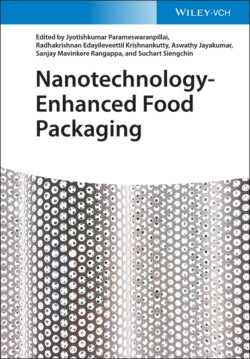Читать книгу Nanotechnology-Enhanced Food Packaging - Группа авторов - Страница 4
List of Illustrations
Оглавление1 Chapter 1Figure 1.1 Features of food nano-packaging applied in the food industry [2]....Figure 1.2 Diverse applications of nanotechnology in the food industry [3]....
2 Chapter 2Figure 2.1 Schematic and chemical structure of collagen (a) and gelatin (b)....Figure 2.2 Polyhydroxyalkanoate (PHA) extraction and its general structure, ...
3 Chapter 4Figure 4.1 Basic cellulose structure.Figure 4.2 Types of nanocellulose.Figure 4.3 Classification of cellulose nanomaterials.Figure 4.4 Different methods for synthesis of nanocellulose.
4 Chapter 5Figure 5.1 Possible terrestrial sources of chitin.Figure 5.2 Possible aquatic sources of chitin.Figure 5.3 Structure of (a) N-acetyl-glucosamine, monomer of chitin; (b) glu...Figure 5.4 Schematic illustration of fully acetylated chitin [poly(N-acetyl-...Figure 5.5 Conventional protocol of chitin and chitosan production.Figure 5.6 Main reactive sites of chitosan.Figure 5.7 Key chemical modifications of chitosan.Figure 5.8 Main methods for preparation of chitosan nanoparticles.Figure 5.9 Schematic illustration of various applications of nanoparticles....Figure 5.10 Main types of polymeric nanoparticles.Figure 5.11 Factors affecting bioavailability and stability of nutrients.Figure 5.12 Application of nanoscience in food packaging.Figure 5.13 Factors controlling the chitosan antimicrobial pathway.Figure 5.14 Possible chitosan antimicrobial mechanisms through (a) electrost...Figure 5.15 Antimicrobial activity mechanism of nanoparticles.Figure 5.16 Application of chitosan nanocomposites in fruit and vegetables p...Figure 5.17 Main factors affecting the absorption of nanoparticles in human ...
5 Chapter 6Figure 6.1 Schematic representation of the different lipid-based nanocarrier...
6 Chapter 7Figure 7.1 Metal and metal oxide nanoparticles used in active food packaging...
7 Chapter 8Figure 8.1 TEM images of assembled and disassembled Ag triangular nanoplates...Figure 8.2 Chronochromic evolution from Au nanorods to Au/Ag nanorods: (a) T...Figure 8.3 Synthesis of cellulose nanocrystal@polyrhodanine nanoparticles th...Figure 8.4 Synthesis of a spirogyras functional nanofibrous mat for visually...Figure 8.5 The color responses of Au@Ag core–shell nanorods to different lev...Figure 8.6 (a) Preparation of refractometric sensors through embedding metal...Figure 8.7 TEM images and the UV–vis absorption spectra of Au nanorods at di...
8 Chapter 9Figure 9.1 Uses of nanotechnology in different food packaging.Figure 9.2 Immersion (a) and spraying (b) techniques to apply edible coats o...
9 Chapter 10Figure 10.1 The process of permeability through a polymer film.Figure 10.2 Tortuous pathway in a polymer nanocomposite.
10 Chapter 11Figure 11.1 Functions of different types of food packaging materials.Figure 11.2 Typical layers and functions of a multilayer food packaging.Figure 11.3 Diagram showing the pathway of molecule (gas and water) transpor...Figure 11.4 Schematic of layer-by-layer (LbL) technique for preparing multil...Figure 11.5 Schematic representation of EHDP method for preparation of nanos...Figure 11.6 Multilayer coextrusion method: a diagrammatic representation....
11 Chapter 12Figure 12.1 Functionalities of active packaging.Figure 12.2 Nanofillers used in active packaging.Figure 12.3 Characterization techniques of nanoparticles.
12 Chapter 14Figure 14.1 Nanomaterials in food preservation.
13 Chapter 15Figure 15.1 Different factors that affect the overall toxicity.Figure 15.2 Possible route of nanoparticle entering into the body [47].
